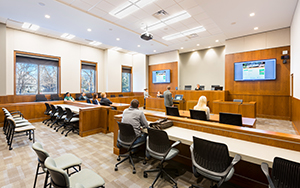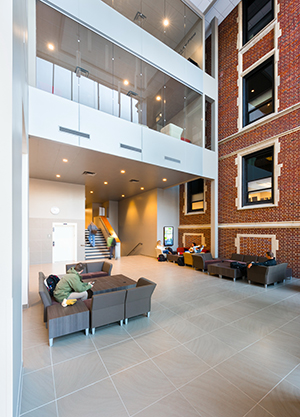A Time of Reflection
Law School Building Project Creates Powerful Learning Spaces
Last October, the UND School of Law celebrated the completion of the building addition and renovation with a ribbon cutting ceremony during Homecoming 2015. That much-needed remodeling, made possible by the generosity of the State of North Dakota and of the many alumni and friends who provided private gifts to complete the project, has proven to be an invaluable investment in educating the future lawyers and leaders of our State and region. The law school community remains grateful for this enduring support of its educational mission to produce the well-rounded legal professionals necessary to meet the challenges of the new century.
As part of the Homecoming dedication, Dean Kathryn Rand invited Professor Patti Alleva, the Webb Professor of Law and Faculty Mentor for Teaching & Learning Enhancement, to speak about the educational significance of the new building. Here, in slightly edited form, are Professor Alleva’s October 9, 2015 remarks to alumni, students, and colleagues.
The Power of New Learning Spaces
Professor Patti Alleva
October 9, 2015
We gather to celebrate a special homecoming. We are together again, for the first time, in a transformed space, as the extended law school family, united in the professional purpose and pride symbolized by this beautiful structure. Thank you for taking time out of your busy lives to reconnect and reminisce. It is wonderful to know that you are back, if only for a little while. But in some ways, you have never left. If you listen carefully, your footsteps echo in our collective memories — for we are all part of a timeless community, that we made together, from the teaching and learning we shared in this place, however many years, tears, and cheers ago. I am grateful to you all for being a part of my life in this way and for the gifts you have given of your professional selves in whatever capacities you have worked or served.
Four Deans. And it is also meaningful that each of the four deans who served this law school during my twenty-eight year tenure have all stood under this new roof over the course of the last two days: Dean W. Jeremy Davis, Interim Dean Candace Zierdt, Dean Paul LeBel, and Dean Kathryn Rand. In ways both direct and indirect, it is the legacy of their leadership that brings us all to this very moment of celebration, and I thank each of them for showing the way forward — with special appreciation to Deans Rand and LeBel for their extraordinary efforts in making this building project possible.
Possibilities. Potential. Promise. That is what this new space bespeaks. That is the energy of this marvelous renovation. So follow me, please, for a few moments, without moving from the comfort of your new seats, through some of the new doors that surround us — new portals of possibility leading to improved learning experiences for our students.

New Classrooms. Take, for example, the new Teaching Courtroom, off the Central Commons. An elegant companion to the classic dignity of the Baker Courtroom, our appellate forum. How wonderful to have this new space, complete with an attached jury deliberation room, for our students to experience the feel of a modern trial courtroom.
And the new Flex or Adaptable Classroom, which can be completely reconfigured in minutes, with hardly any effort at all, from traditional front-facing rows to small work-group tables positioned near one of the four wall-screens so that students can project their work for common viewing and critique. And the new Case Study Room, arranged in a “U”-shape with graduating rows, excellent sight lines, and a formal informality to facilitate comfortable discussion, even in a medium-sized class.
These new spaces help to move the educational endgame from “what our students know” to “what our students can do.” The more flexible, the more spacious the room, the more the chairs roll or swivel, the more we can use small groups or other interactive methods to engage students in dialogue about the concepts they are learning, even in large doctrinal classes. Small group discussions also help students to develop the relational skills necessary to handle group dynamics. In addition, they illustrate the benefits of collaboration and learning from peers.
These are essential skills for the practicing lawyer — all of which become more possible to cultivate in adaptable learning environments that support the teaching strategies necessary to facilitate deeper learning centered in the student. Because when all is said and done, the learning — and doing — must come from inside the student. As an active partner in the learning process, each student must make the concepts and skills his or her own, and create professional meaning for themselves in their own words and actions, integrating knowledge, skills, personal experiences, and ethical values into an evolving sense of professional self. It is exactly this type of engagement — along with opportunities for students to work-in-role in both simulated and live-law contexts — that will help each student to develop a sturdy foundation for the lifelong learning at the heart of successful lawyering. And we are very thankful that our new classrooms make it easier for different forms of active learning to happen.
Architecture As Teacher. But as wonderful as they are, the new classrooms tell only part of the story of our revitalized learning environment. I have walked these new halls for more than a month now. And I have come to appreciate the wisdom of the overall design. I have come to see that these new learning spaces — not only the classrooms, but the building as an organic whole — are themselves teachers of so many lessons. I have come to see and feel, reflected all around me, in the structure and flow of the architecture, so many of the things that work to support meaningful and successful educational experiences. If I may illustrate:

My favorite place in the new design is the Central Commons. There is so much that this space teaches — and without a word spoken. Indeed, for the first time in my tenure here, there is a true focal point for our learning community, a beautiful, breathing expanse with stunning floor to ceiling glass, three stories high, bringing the trees and the blue sky inside the building. It is such an inspiring space, energizing in its openness yet calming in its link to the natural world. It is a place to gather, a place to ponder, a place to converse, a place to linger, a place that puts you in touch with something intangible and greater than yourself. It almost asks you to stay awhile. And it subconsciously reminds, with persuasive simplicity, of the importance of being together, of occupying the same physical place, of talking, and not texting, and of feeling the singular power of human connection and live conversation.
These things are vital to learning. Indeed, creating a community where students feel connected — to the educational mission and to each other — is so important to motivating learning. So important to creating bridges of understanding between people, especially those who are different from one another, so that they are comfortable sharing ideas and learning from each other. Indeed, creating that feeling of connection is so important to helping demonstrate that we need each other — need to understand each other — not only to learn the law, but to practice it with humanity and humility. In this depersonalized age of electronic and instantaneous communication, we must find our way back to each other with the power of personal presence, expression, and patience. The Central Commons — especially coupled with the two beautiful overlooks on the floors above and the various sitting clusters or small meeting rooms throughout the building — provides the space and inspiration to have those conversations, to make those connections, and to build those bridges in ways that weren’t possible in the old building.
And perhaps most of all, standing in the Commons, especially in the early morning when it is empty and expectant with silence, I feel the dignity of this new space. The height, the light, the harmony of outside and inside imparts a feeling of peace and quiet pride — for the profession that we are privileged to be part of. Those magnificent vistas of the Central Commons say “think big, think beyond yourselves, aspire to be the best that you can be, and open your minds and heart to learn, and learn deeply.” That is what I hear these spaces teaching. Those are the special lessons of the architecture.
So before we go, please take a virtual walk with me, once again, into this building. In your mind’s eye, walk down the new front path to the new main entrance, and pause, before you come in, to see, on your right, the old building. And on your left, the new — a virtual double or mirror image of the old, linked in the middle by the gleaming transparency of the Central Commons. Now walk through the double set of glass doors into the Commons, and notice, to your right, that the beautiful brick of the old building provides one wall of that room, to remind us of strong foundations, of where we began.
I register somehow, some way, consciously or unconsciously, the sublime power of this space each time I am in it. It embodies a stirring combination of the old and new, repurposed in the crucible of the Commons, which speaks symbolically to the importance of honoring where we came from and where we are going — a sense of history and a sense of possibility. I feel at once anchored in the familiar feel of the old, yet pulled into the kinetic potential of the new. And that is exactly what I hope our students will feel during their educational journey in these powerful new learning spaces: Strongly supported and safely grounded, yet free to grow as independent learners and fledging professionals enticed by the call of a noble career and the chance to make a difference.